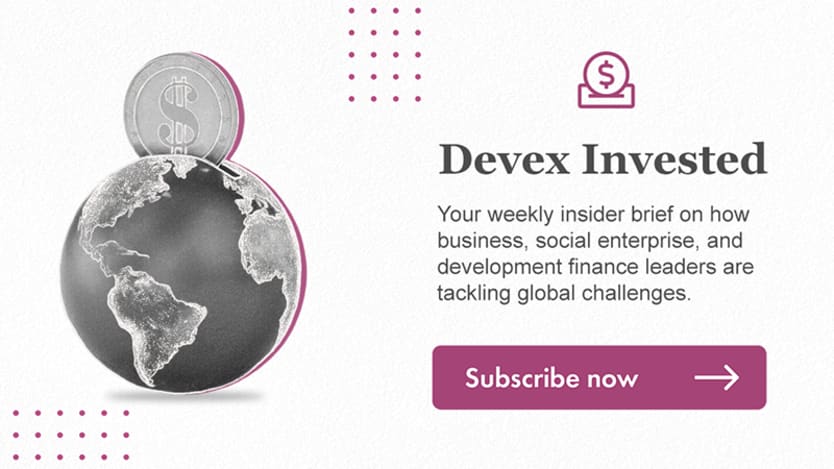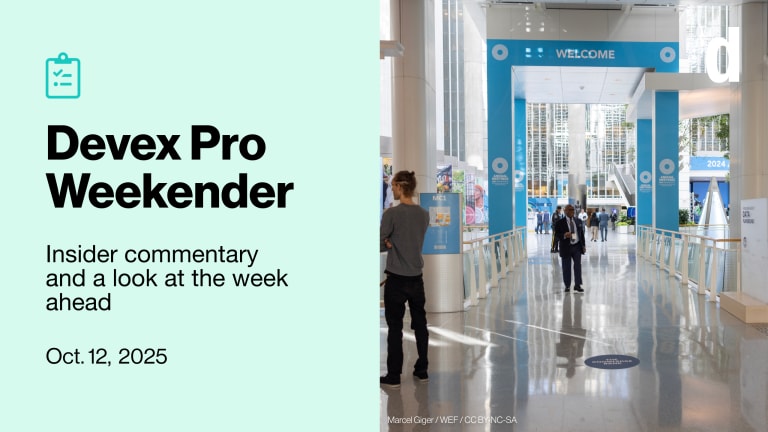
Debt pressures are rising to levels not seen in decades, but there seemed to be little progress on debt last week at the World Bank Group-International Monetary Fund and Group of 20 meetings.
Three countries — Chad, Ethiopia, and Zambia — have started working through the G-20’s Common Framework, a sovereign debt restructuring initiative that launched in 2020. But many more are likely to need help amid mounting struggles to foot the bills for food, energy, inflation, and climate crises.
This is a preview of Devex Invested
Sign up to this weekly newsletter inside business, finance, and the SDGs, in your inbox every Tuesday.
Meanwhile, climate-vulnerable countries are seeking debt relief so that they can channel more money to climate adaptation, and some might even be considering halting their repayment of debt and loans, according to The New York Times. One of the proposals being floated is debt-for-climate or nature swaps, where a portion of debt is forgiven and invested in conservation or climate-related projects.
I had a few conversations last week about the role impact investors might play in debt relief — including helping to structure and incentivize debt-for-climate or Sustainable Development Goals swaps. The idea seems nascent, but falling bond prices could make these swaps attractive to private investors too.
My colleague Shabtai Gold was running all over D.C. at the World Bank-IMF meetings. Here are his takeaways:
• MDB reforms: One message that came across was that it may be time for multilateral development banks to change. The United States and Germany, along with others, called on the World Bank to make some reforms, including lending more money more quickly and boosting spending on climate.
A group of foundations is also pushing MDBs to reform. The $5 million Multilateral Development Bank Challenge Fund — launched last week by the Bill & Melinda Gates Foundation, Open Society Foundations, and The Rockefeller Foundation — aims to help MDBs “expand capacity” and “scale up lending” in low- and middle-income countries, my colleague Stephanie Beasley writes. And ICYMI, last week, OSF’s President Mark Malloch-Brown told Shabtai that donor countries are “on the hook to deliver” support to lower-income countries at a time of historic upheaval.
• “Headroom” to lend more: In a plot twist for the closely watched G-20 report on MDBs, we learned last week that leading credit rating agencies Fitch Ratings and S&P Global Ratings disagree on whether MDBs can lend more without hurting their coveted AAA status. S&P says MDBs have “headroom to increase risk appetite,” Alexander Ekbom, the agency’s senior director of multilateral institutions and supranationals, tells Shabtai. How much isn’t clear, and the banks should still guard against the potential for economic conditions to deteriorate, he adds. Fitch analysts were far more downbeat earlier this year on the potential for downgrades.
• Up and running: The IMF’s Resilience and Sustainability Trust is officially operational. So far Barbados and Rwanda have signed agreements to access the capital, which comes in the form of loans providing budget support for long-term projects such as climate adaptation. Some African ministers complained last week that the eligibility process is too cumbersome.
• SDRs not in the cards: There have been calls for another issuance of IMF Special Drawing Rights to help countries deal with overlapping food, energy, and inflation crises. But the odds dropped significantly last week when U.S. Treasury Secretary Janet Yellen said: “We do not see another SDR allocation as appropriate at this time.” It has also been a challenge to get U.S. congressional approval to reallocate existing SDRs from the last issuance in 2021.
Read more: Development banks have ‘headroom’ to lend much more, S&P says (Pro)
Catch up: Read all our coverage of the World Bank-IMF annual meetings
Check out: Our new series Road to COP 27 unpacks everything you need to know about the 27th United Nations Climate Change Conference in Egypt next month.
+ Get the most out of coverage by becoming a Devex Pro member. Start your 15-day free trial today.
Corporate coffers
Economic doom and gloom, cuts to donor aid budgets, and not much hope for financing the Sustainable Development Goals of late. But a new initiative aims to mobilize new money — that holy grail — from an unexpected private source: corporate balance sheets.
While still an emerging area, corporate impact investing could mobilize money that today sits on the sidelines in corporations’ treasuries. Companies are trying different ways to invest that capital with an impact intent and that spurred the Global Impact Investing Network to launch an initiative to help mobilize some of that roughly $2 trillion sitting on corporate balance sheets. Its first order of business will be mapping how different companies approach the issue and creating a guide for those considering it, GIIN’s CEO Amit Bouri tells me.
Corporate Impact Investing: Will it bring in new money?
Blockchain for conservation
Can blockchain help deliver last-mile payments to the Masai, a pastoralist community in Kenya, and ensure they receive fair payments linked to conservation efforts? My colleague Sara Jerving has a story exploring an effort to do just that.
Mara Foundation, the impact-driven nonprofit arm of African digital finance ecosystem Mara, is working to determine how decentralized blockchain solutions can improve transparency, equity, and speed of payments.
Explore this visual story: Can blockchain help conserve Kenya's Masai Mara?
Your next job?
Senior Advisor: Sustainable Finance
The Nature Conservancy
United States, Latin America, and Caribbean
What we’re reading
UN, EU push back as Sweden drops 1% aid target. [Devex]
OSF’s Malloch-Brown calls on the rich world to boost aid or lose ‘legitimacy.’ [Devex]
G-20 statement issued three days late amid divisions over war, oil. [Bloomberg]









